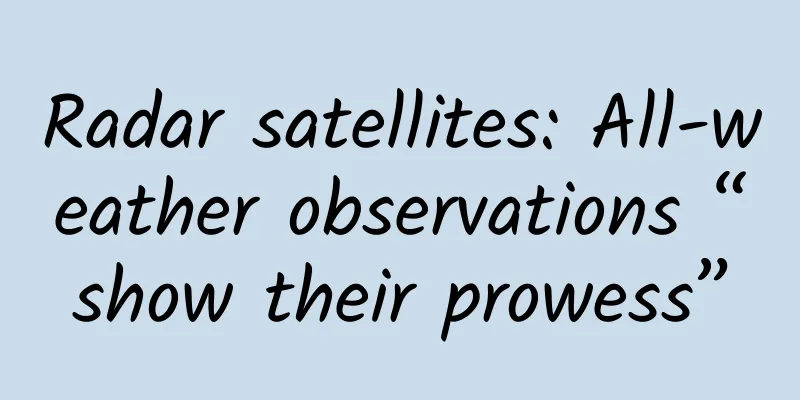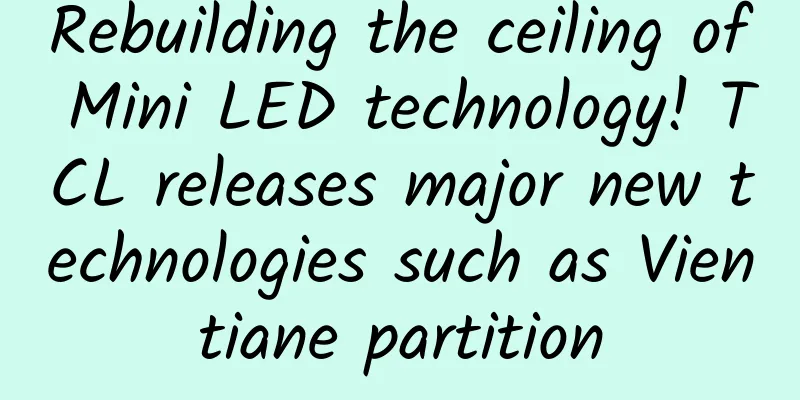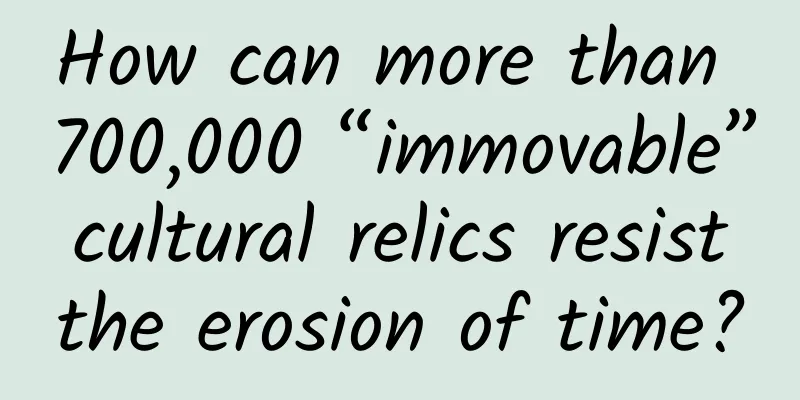Radar satellites: All-weather observations “show their prowess”

|
Recently, the American weather data company announced that it plans to launch dozens of radar satellites to provide real-time meteorological observation data for weather forecasts around the world to improve weather forecasting and prediction capabilities. As we all know, the meteorological satellites that everyone is familiar with today are passive visible light and infrared remote sensing satellites. In an era when optical meteorological satellites have already shown their prowess, why do we need to develop radar satellites specifically? Optical remote sensing is flawed Among the earth remote sensing satellites currently developed by countries around the world, optical remote sensing satellites are the main branch, and all meteorological satellites use optical remote sensing technology. Today, the maximum resolution of this type of satellite can reach 0.1 meters. These "eyes" deployed in the sky by countries around the world allow people to have a clear view of the ground from space. Space remote sensing has the advantages of wide observation range, low observation cost and abundant observation data, which greatly expands human's understanding of the earth. However, optical remote sensing satellites also have many obvious disadvantages. All optical remote sensing satellites work passively, and imaging is seriously affected by light conditions. Take common earth remote sensing imaging satellites as an example. They are capable but incapable of operating in adverse weather conditions such as clouds, fog, haze, rain, snow, or at night. In other words, even if optical remote sensing satellites have advanced performance, they are easily affected by atmospheric conditions, especially meteorological conditions, and cannot operate around the clock. Faced with the insufficiency of optical remote sensing satellites, researchers have long had a plan to deal with it. Radar appeared before World War II and developed rapidly during World War II. In the 1950s, synthetic aperture radar technology (SAR) was proposed and successfully developed. Simply put, it actively sends radar waves to detect targets, and at the same time, through the continuous movement of a small aperture antenna, the amplitude and phase of the received signal are superimposed and processed, and the small aperture antenna is virtualized as a large aperture antenna, thereby achieving high-precision ground remote sensing. Synthetic aperture radar has been applied in aviation remote sensing, and soon became a new star in space remote sensing. This radar satellite has the ability to obtain remote sensing data in all weather and all day, effectively making up for the shortcomings of optical remote sensing satellites, and has been widely used in the fields of aerospace and national defense. Radar satellites can work around the clock Radar satellites have many superior capabilities that optical satellites do not have. This is most evident in their ability to penetrate the atmosphere and produce stable images regardless of weather conditions such as clouds, fog, rain, and snow. They can maintain remote sensing capabilities at all times of the day and in all weather conditions, and night imaging is also their forte. These advantages have quickly made it one of the mainstays in the field of aerospace remote sensing. The advantages of radar satellites are not limited to all-weather operations. Compared with optical remote sensing satellites, radar satellites' radar waves can penetrate soil and vegetation. In other words, they can detect underground targets. Radar remote sensing has different penetration depths in different bands. Through SAR radar satellite remote sensing in different bands, surface soil characteristics can also be inverted. In addition, the radar wave band of radar satellites is far different from the visible light or infrared of optical satellites, and can reflect remote sensing information at different levels. At the same time, radar images can better reflect the water content and salt content of the ground, as well as the shape and texture characteristics of ground objects. Combined with optical remote sensing data, they can better describe the targets detected by remote sensing. In addition, the resolution of SAR radar imaging depends on the size of the synthetic aperture, and the satellite imaging resolution has nothing to do with the orbital altitude, while the resolution of optical remote sensing is inversely proportional to the orbital altitude, and the higher the altitude, the lower the resolution. Radar satellites also have different beam working modes, which make imaging more flexible and provide richer resolution capabilities. Therefore, compared with traditional optical remote sensing satellites in visible and infrared bands, radar remote sensing satellites have irreplaceable advantages and play an important role in aerospace remote sensing. Of course, radar remote sensing satellites have a long working band, and the resolution of X-band SAR satellites is only about 0.3 meters. The resolution of other commonly used bands is even lower. The combined use of the two satellites is more effective. Radar remote sensing satellites have also begun to be used in the field of meteorology. Traditional meteorological observations are a combination of optical meteorological satellites and ground-based meteorological radars. Although satellites provide a wide range of optical observation capabilities, the resolution is too low and cannot detect internal conditions; ground-based meteorological radars have limited coverage, but can penetrate clouds to detect and identify the internal structures of various weather systems. For example, the US GPM satellite carries a dual-frequency rainfall radar that can reliably monitor typhoons and rainstorms while observing rainfall. Radar satellites have a bright future Although radar satellites have been widely used, their development is still in the ascendant and will be more widely developed and used in the future. Radar satellites are also making continuous technological progress. Based on the extremely wide band characteristics of radar waves, an important trend in SAR radar technology is to make full use of the relationship between the electromagnetic characteristics of ground objects and the frequency of radar waves, and use electromagnetic waves of different frequencies to detect targets in order to obtain richer information. This can be figuratively called radar remote sensing hyperspectral technology. In addition, different polarization modes of radar remote sensing will also bring different remote sensing images, which is conducive to more complete target detection. Nowadays, SAR radar technology has also developed interference technology. Various interference methods can further detect the elevation or speed information of ground targets and solve the shortcomings of traditional SAR radar satellites. At the same time, the beam imaging mode of SAR radar technology is also developing further, providing users with richer remote sensing target information. Optical remote sensing satellites are developing towards micro-satellites, satellite formations and remote sensing constellations, and the same is true for radar satellites. In order to shorten the revisit period of a specific area, that is, to improve the temporal resolution, the use of multiple radar satellite constellations can significantly increase the coverage density and shorten the revisit period. In addition, the coordinated work of multiple satellites is also an important direction for the development of radar satellites. SAR radar technology is a virtualization of a single satellite radar antenna as a large antenna, and multiple satellites form a specific shape in orbit, forming a virtual satellite and a virtual large antenna, which can provide the same functions and performance at a lower cost, replacing large radar remote sensing satellites. The new generation of radar satellites of the American Weather Data Company is a representative of the development of radar satellites. They plan to launch the first satellite in the second half of 2022, followed by a meteorological satellite constellation consisting of dozens of small radar satellites. The company said that although ground-based weather radars provide information on rainfall and cloud structure to various countries, their coverage limits their forecasting capabilities, and the long revisit period of space-based radar satellites also limits their role. The company's small radar weather satellite constellation is expected to provide the ability to revisit once an hour, which will provide accurate and timely meteorological information for accurate weather forecasts around the world. (Author: Zhang Fan) |
>>: The college entrance examination papers were printed in prison? What happened? Revealed!
Recommend
Kuaishou launches new strategy for placing information flow ads
Recently, many optimizer friends have consulted a...
The deposit reserve ratio has been lowered again! What does this mean?
On Monday, the People's Bank of China announc...
How to write a good opening that kills people: 3 new media writing tips I learned from TED
As a new media marketer , your weapon is articles...
Lamb, tofu, seafood... Do we have to stop eating these "irritating foods" if we get hurt?
After an injury, you always want to take good car...
Marketing node reminder in May
April is coming to an end and May is approaching....
Choosing an enterprise-level mobile platform: an independent platform or an integrated platform?
The rapid development of mobile Internet not only...
Who is to blame for the chaos in the film and television industry where unprofessional young actors have become the target of public criticism?
Nowadays, the film and television industry can no...
SF Express’s triple-proof mobile phone is tested: automatically reset to zero at midnight!
Two weeks ago, spy photos of SF Express's thre...
The official version of iOS 17.0.3 is released, and the heating problem is finally solved!
iOS 17.0.3 official version released This morning...
Is the universe starting to produce "raspberries"? In fact, it is a newly discovered supernova remnant! | Expo Daily
Is the universe starting to produce "raspber...
Does water have a color? Why is swimming pool water blue?
Today's Tadpole Quiz is here! The above is @A...
Zhang Xuefeng 2021 College Entrance Examination Volunteer Application Tutoring Course
Zhang Xuefeng's 2021 College Entrance Examina...
The official version of iOS 17.4 is here, summary of new features!
Early this morning, Apple pushed the official ver...
100% Method to Create a Hot Short Video Account
In the era of attention economy, short videos hav...









